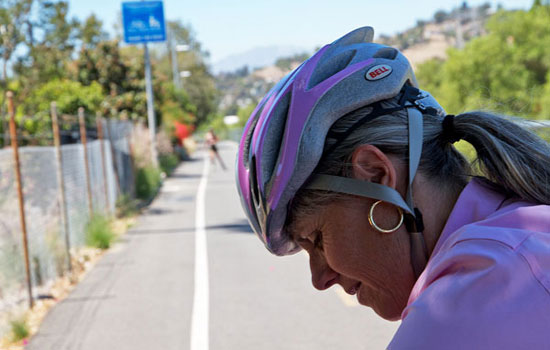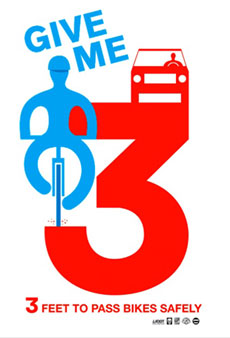New law puts bike czar in rider’s seat
September 26, 2013

Senior bike coordinator Michelle Mowery has seen a sea change in attitudes about biking in Los Angeles.
You’ve got to hand it to Michelle Mowery. For two decades, she’s persevered, holding the job of “bicycle coordinator” in the nation’s most car crazy city. “A candle in the wind,” she calls herself. Make that a hard-blowing headwind.
But now, almost overnight, Mowery’s mandate has found a powerful constituency in City Hall and on the roads, giving her once-invisible position in the Los Angeles City Department of Transportation rising stature.
“We’ve put in more bike lanes in the past two years than during my entire career here,” she says. “We have a lot of work to do, but we’re getting stuff done.”
The latest achievement came this week, when Gov. Jerry Brown signed a law requiring California motorists to stay at least 3 feet away from cyclists when passing—a requirement already in effect in 22 other states. Four earlier versions of the measure had died because of various safety and liability concerns.
 When Mowery heard the news on Monday, she says one word came to mind: “Finally.” For years, she had championed such a law, alongside elected officials in Los Angeles and bicycle advocates statewide. She praises the measure as “a start and an acknowledgement that cyclists need that little bit of space to stay safe.” It will take effect next September.
When Mowery heard the news on Monday, she says one word came to mind: “Finally.” For years, she had championed such a law, alongside elected officials in Los Angeles and bicycle advocates statewide. She praises the measure as “a start and an acknowledgement that cyclists need that little bit of space to stay safe.” It will take effect next September.
According to the California Bicycle Coalition, which launched a “Give Me 3” campaign with Los Angeles advocates to give visibility to the issue, passing-from-behind collisions are the state’s leading cause of bicyclist fatalities. In fact, Mowery says, a galvanizing moment in the long effort to win passage of a buffer zone for cyclists came in 2006, after popular UC Santa Barbara triathlete Kendra Payne was struck and killed by an asphalt truck that tried to pass her on a sharply-curving road.
Mowery says existing California law simply states that drivers must keep a “safe distance” when passing cyclists, a subjective standard. Now, she says, law enforcement has been given a specific tool to cite motorists who invade a rider’s legal space. Even if police don’t make enforcement a top priority, the legislation’s educational value alone could save lives, says Mowery, a lifelong cyclist who’s now 54. She added that this is especially true in Los Angeles, where riders often need more room to dodge bad pavement conditions. “They’re not always able to ride in a straight line,” she says.
Mowery attributes the growing clout of cyclists to shifting demographics. She says that when baby-boomers like her learned to drive, the region’s freeways were new “and wide open. It was the land of opportunity for cars.” These days, however, the under-30-crowd is driving less, while increasing numbers of teenagers are deciding not to even get drivers licenses.
“They see people sitting in traffic and it doesn’t look like fun,” Mowery says.
Eric Bruins, planning and policy director of the Los Angeles County Bicycle Coalition, agrees, calling this “a golden era for bikes.” The new buffer-zone law, he says, is a “huge” step forward. “For us on the street, this is something we encounter every single day. Everybody just needs a better understanding of what it means to pass safely, and that’s what this law provides.”
Bruins credits Mowery with being a leading force behind the new law through her advocacy in Los Angeles and as a member of statewide cycling organizations. “I don’t think the bike community has understood what a quiet champion she has been…She’s been trying to get this [law] passed forever.”
Bruins says that, for years, Mowery had been a controversial figure, the public face of City Hall recalcitrance to demands for more bike friendly streets. But now, with the growing influence of Los Angeles cyclists, Bruins says, the city’s bike boss is riding high.
Says Bruins: “She is finally empowered to do her job.”
Posted 9/26/13












 405 bridge work causes a stink
405 bridge work causes a stink

